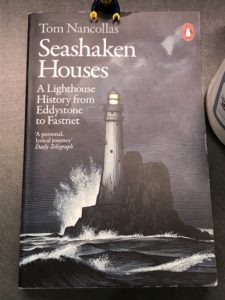
A Special Report from Agent Hunt
Maybe it’s because we’re an island nation, with a proud history of seafaring. Maybe it’s because my early years were spent living on the coast. Whatever the reason, the sea has always fascinated.
That said, I’ve never been particularly fascinated by lighthouses, as interesting as they are. Unlike writer and building conservationist Tom Nancollas. His love and admiration for these stone monoliths shine through in his book Seashaken Houses, from the cover right through to the epilogue.
Focusing on rock lighthouses, i.e. those built on rocks out at sea (not say, on a cliff), Seashaken Houses is essentially a book of three parts, all intertwined. Firstly there are the rock lighthouses themselves; strong, stout, and often with a very long a complicated history. Construction started on the first Eddystone lighthouse in 1696 and replaced three times since.
Nancollas’ book talks about the early failures of the lavish iron towers, and their development into the granite beasts we have now. There’s an interlude in the middle of the book which talks about a lighthouse that was built in the middle of a city, far from the ocean, and another about a lighthouse wrapped around another, like nesting dolls.
The second part of the book is a history lesson, what drove the towers to be built? Who paid for them and who took the income (yeah, income was a thing). Why were Scottish and French lighthouses better than English?
 It turns out that each tower shines a light (pun intended) on the needs of society at the time, and the stories that fill out the book are a lot more than just lists of shipwrecks. Who were the giants of industry and design responsible for these and how did they evolve from well-meaning follies to actual, life-saving behemoth?
It turns out that each tower shines a light (pun intended) on the needs of society at the time, and the stories that fill out the book are a lot more than just lists of shipwrecks. Who were the giants of industry and design responsible for these and how did they evolve from well-meaning follies to actual, life-saving behemoth?
Lastly, the book is a journal of the personal adventure that Nancollas went on to visit and document these buildings and their former keepers (spoiler, they’re all automated now). This was the part I found least interesting and would occasionally glaze over. It’s not navel-gazing by any means, it’s just that I didn’t feel it necessary.
The quote on the cover says “a personal, lyrical journey”. This is apt, but the text was slightly too lyrical at times. On occasion I found myself thinking ‘point made, move on’. Sometimes 50 words were used when 10 would have sufficed. This is a minor nag though, and I enjoyed the book and would recommend it for anyone with an interest in social or maritime history.
Agent Hunt aka Mike Laybourne (@mikelaybourne) is a British husband and father to two girls. Aside from briefly playing bass in a short-lived band, he’s never had any musical aspirations despite being fortunate enough to live in Manchester; the music capital of the world. He can be found contributing to the4thlinepodcast.com and believes everything sounds better on vinyl. Check out his previous A to Z Playlist or his other Collaborated British Isles A to Z Playlist.